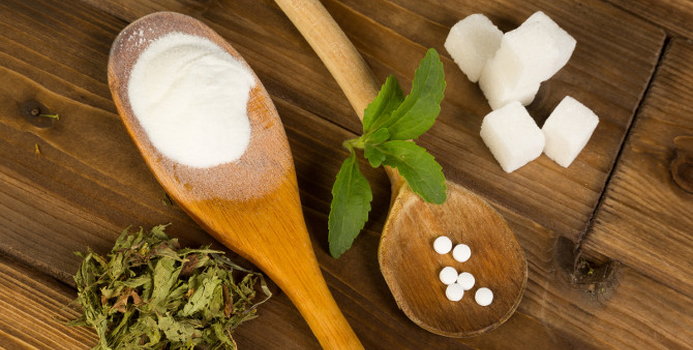Though there is no official FDA definition, it is generally accepted that artificial sweeteners are sweeteners that are synthetic in nature, i.e. manufactured, rather than naturally occurring. The line between "natural" and"artificial" can be somewhat fuzzy at times. Sucralose, a sweetener derived from sugar, is judged to be artificial, while the rebaudioside A in Coca-Cola's Truvia sweetener, produced via a patented process using the leaves of a genetically modified Stevia plant, is considered "natural." All artificial sweeteners are regulated by the U.S. Food and Drug Administration as food additives.
Regardless of their exact classification, artificial sweeteners are a large part of the sugar substitute market, with companies vying for FDA approval of new zero or low calorie artificial sweeteners every year. Here's a list of the most popular:
Acesulfame Potassium
Acesulfame Potassium, first discovered in the 1960s, is around 200 times sweeter than sugar. It is usually marketed under the brand name "Sunett," and is found in some chewing gums, low-calorie syrups, and instant gelatin or pudding desserts.
Aspartame
Aspartame, most commonly known in the United States as the main ingredient in Nutrasweet and Equal artificial sweeteners, is found in thousands of products worldwide. Since it breaks down at high temperatures, aspartame is not used as much in baking as some of the other artificial sweeteners. It is also about 200 times sweeter than sugar
Cyclamate
Cyclamate-based sweeteners are currently banned in the United States, though they are available in over 50 other countries, including Canada and the United Kingdom. This dual status affects some well-known artificial sweetener brands, forcing them to change their ingredient list depending on the country they are meant for eventual sale in. For instance, the Sweet-N-Low and Twin Sugar sweeteners sold in the United States are saccharin-based, but in Canada, where saccharin is banned, the versions of each are cyclamate based.
Neotame
Neotame is one of the newer artificial sweeteners, first approved by the Food and Drug Administration for use in 2002, manufactured by NutraSweet to complement that company's line of aspartame-based sweeteners. Neotame is 8,000 times sweeter than table sugar, and is marketed as a "flavor enhancer," as well as a sweetener. It is primarily used in some house-brand grocery store juices, instant tea mixes and low-carb breads.
Saccharin
The oldest of the artificial sweeteners, sacchrin was first produced in 1878, though it did not become popular until the sugar shortages of World War I. Saccrhin is about 300 times sweeter than sugar, but has an unpleasant metallic aftertaste, so in many cases it is mixed with another sweetener.
Sucralose
Sucralose is the main ingredient in the artificial sweetener Splenda, sold the United States. Sucralose is derived from sugar, created by a chemical process where the molecular hydrogen and oxygen pairs in sugar are replaced with chlorine molecules, resulting in a sweet substance. Like all of the artificial sweeteners it attracts various negative health claims, but all, save for cyclamate, have been determined to be safe by the FDA.



